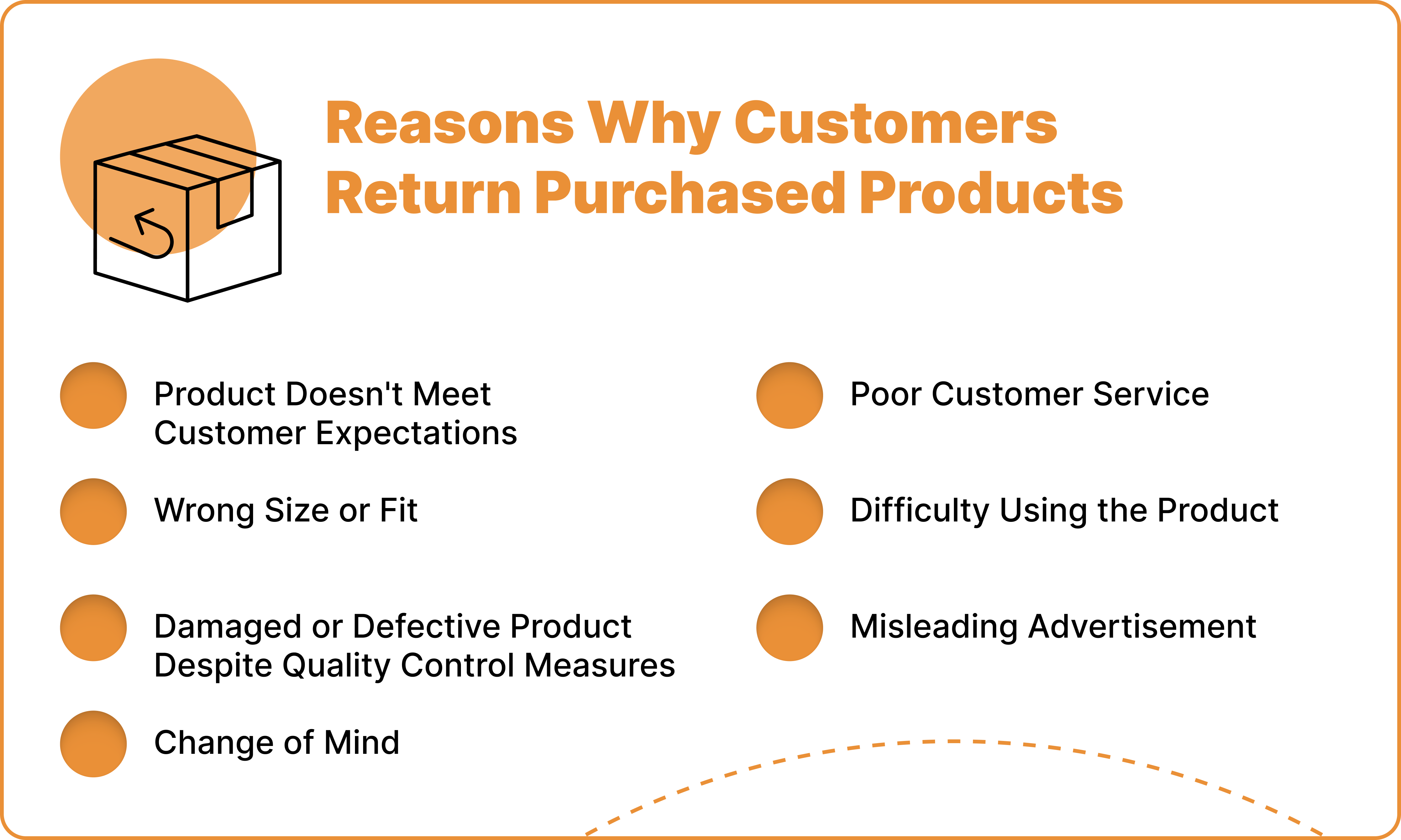7 Reasons Why Customers Return Products

39% of consumers return one or more items every month, according to a survey. There are several reasons why customers return products. For instance, 57% of shoppers returned their last product due to shipping and operational issues, and 64% returned products because they looked different from the picture or because the product description did not match. Unfortunately, whatever the reasons for these returns are, e-commerce businesses and online stores are left holding the short end of the stick.
However, when a retail business understands the problem and reasons for customer returns, it can leverage that information to make changes and potentially enhance customer satisfaction. A flexible return policy builds trust and encourages customers to make purchases with greater confidence. This article’s primary objective is to highlight reasons why customers return purchased products, allowing e-commerce platforms and retailers to identify familiar issues and take the necessary steps to fix them.
Reasons Why Customers Return Purchased Products

Today, goods are returned at an alarming rate, especially those from online shopping. And there are seven major reasons why customers are forced to make returns. Sometimes, the business is at fault; other times, it can’t do anything about these returns. However, understanding the problem can help streamline the returns management process and overall supply chain to mitigate it.
So, what are the reasons why customers return purchased products?
1. Product Doesn’t Meet Customer Expectations
For all the talk about being unable to control customer reactions, one of the biggest reasons for returns is that the product doesn’t match or meet customer expectations. Unfortunately, this particular problem does manifest itself in several ways, including:
The product is not what was described on the platform
For instance, the platform’s description promised an OLED TV, but the customer purchased it and found it was not an OLED TV.
The product doesn’t look like it did on the platform
We live in an era where photos can tell a thousand words, but none of them is true. Unfortunately, this trend finds its way to e-commerce platforms, and customers make purchases thinking one thing while the product is nothing like it is in the picture. This is common with fashion products and some home appliances.
Product quality is lower than expected
Low-quality products often trigger customer returns because they perceive them as a waste of money.
Fortunately, these problems are 100% the business’s fault, which means they are fixable. Some tips to leverage are clear language and high-quality images for the product description and quality control measures across the entire supply chain. (Do check this article to learn strategies for addressing these causes.)
2. Wrong Size or Fit
Sizing is a significant reason for returns, especially for fashion and mechanical category products. And it can happen for several reasons. Some of these include:
The customer ordered the wrong size
In this case, the customer may have misjudged or ordered the product based on incorrect information about the size. They return it immediately upon realizing these mistakes because they serve no purpose to them. They might as well get the right fit.
Product sizing is inconsistent
This is typically the case with e-commerce platforms domiciled in other countries. For instance, the sizes of the U.S. and the U.K. differ. Purchasing a product across the pond could easily lead to these sorts of issues. Brands can take time to include the different measurement types and the standards used to avoid confusion and increase overall customer satisfaction. Addressing these sizing inconsistencies can significantly increase customer satisfaction by ensuring that buyers receive the correct order every time.
3. Damaged or Defective Product Despite Quality Control Measures
This situation is problematic for both the customers and the business. From the customers’ point of view, it can be frustrating because they have to deal with the returns process and then still wait for the right product. On the part of the business, that could very well be a loss if they do not have the necessary insurance to cover such costs. To mitigate this, swap the product as quickly as possible and offer store credit or quick cash refunds.
Here are some scenarios where this problem happens to be the reason for product returns:
Product arrived damaged
This typically occurs during shipping, but sometimes it may come that way from the factory, so it is not always the retailer’s fault. However, in both instances, it is a product that has to be returned.
The product malfunctioned shortly after the purchase
The product may work initially and then malfunction after some time or before the warranty is up. This is a problem because it suggests poor product quality, especially for a first-time customer.
4. Change of Mind
There are several reasons why customers may change their minds after buying a certain product, and in many cases, they have nothing to do with the business or the service. Businesses are at the mercy of these types of customers, and this is also a major reason why some of them insist on customers paying for the returns shipping or reverse logistics service.
Here are some common reasons why customers may no longer need a product after purchasing it:
Changed circumstances
Take, for example, a customer who purchases a travel bag because she is going on a trip. Then, suddenly, things change. The travel bag is no longer useful, and in many cases, this will prompt a return from the customer.
Found a better alternative
There are so many options online, and sometimes, customers make price and quality comparisons. Sometimes, their friends hook them up with a better alternative. This will typically prompt returns or cancellation of orders.
5. Poor Customer Service
Customer service is key to reducing and managing product returns, especially when the fault is with the business or its supply chain. When customers experience poor service in the delivery process, they may return the products outright.
For instance:
Late deliveries
In a world where delivery speed is king, late deliveries can be a major turn-off for many customers. A late package can disrupt the customer’s plan, especially for true time-sensitive products. The product can become irrelevant in such cases, leading to a return.
Lack of effective communication
Lack of communication from the automated systems or customer service team leads to transparency, which inevitably breeds mistrust. Customers feel uninformed or ignored when there is no clear and proactive communication. Opting for a return is a natural way to regain control over the entire situation.
Payment-on-delivery challenges
Any issues in the delivery process can create additional complications for customers who choose to pay upon delivery. Because they have not committed through the online payment options, it is very easy to decline the order as a form of retaliation if they feel they have been underserved.
Always remember that effective customer experience goes a long way to manage customer expectations and enhance their satisfaction.
6. Difficulty Using the Product
Some products can be complex or challenging to use, leading to frustration and returns. This typically applies to new brands or products on the market and when someone other than a regular customer is trying out the product for the first time.
Typical examples are exercise equipment such as treadmills or dumbbells because they can be hard to commit to on the first try. Other instances where this is the case include situations where the product is too complicated to set up, such as a baby crib, and when instructions are unclear, such as a DIY air compressor.
7. Misleading Advertisement
Customers feel misled when a product doesn’t perform as advertised, either through the retail platform or through whatever advertising channel the manufacturer decides to leverage. Sometimes, wrong information could also be disseminated through word of mouth, say from a friend or family member with a wrong idea of the product. They will often return the product because it did not perform as they thought it would.
Reasons Not Withstanding, You Can Reduce Customer Returns and Increase Customer Loyalty With ReverseLogix
Although product returns are inevitable, managing returns can be seamless. At ReverseLogix, we leverage various tech solutions to ensure an optimal returns management process because we know it is key to gaining customer loyalty. However, we still believe that the best returns are the ones that never happened. With a robust returns management system or platform, we provide an effective returns policy, facilitate transparency, integrate returns management software and fraud prevention, and manage customers’ expectations to help reduce customer returns across the board. Get a demo with us today.
Frequently Asked Questions
Businesses can reduce returns by providing accurate product descriptions and images, offering clear sizing guides, ensuring product quality, and improving their service and communication to encourage customers.
Product returns can be costly for businesses due to shipping, restocking, and potential losses from damaged or unsellable items. Too many can add pressure to the return process and negatively impact customer experience and brand reputation.
Customers can reduce the likelihood of returns by carefully reading product descriptions and reviews, paying attention to sizing information, and considering their needs before purchasing.
